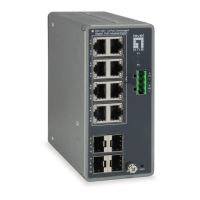
Do you have a question about the LevelOne IGP-1271 and is the answer not in the manual?
Details the default values and initial login procedure for web-based management.
Allows identification of the system by configuring contact, name, and location.
Configures IP basic settings, control IP interfaces, and IP routes.
Configures Green Ethernet features for power saving.
Allows configuration of port power saving features, including EEE.
Configures port detail parameters, including speed, duplex, and flow control.
Configures port settings like speed, duplex, flow control, and frame size.
Configures DHCP snooping parameters to prevent unauthorized DHCP servers.
Configures global and VLAN modes to enable/disable DHCP server.
Configures DHCP snooping parameters to enhance network security.
Configures security settings including user management, authentication, and access control.
Configures user accounts, privilege levels, and authentication methods.
Configures network security features like ACL, Rate Limiters, and IP Source Guard.
Configures Link Aggregation settings for bundling ports.
Configures Link Aggregation Control Protocol (LACP) parameters.
Configures loop detection and prevention mechanisms on switch ports.
Configures Spanning Tree Protocol (STP) settings for loop prevention.
Configures Power over Ethernet (PoE) settings for port power delivery.
Configures PoE port settings and shows PoE supply status.
Configures LLDP-MED for VoIP devices, including QoS and location discovery.
Provides port statistics information and overview of general traffic statistics.
Monitors DHCP server statistics, bindings, declined IPs, and snooping tables.
Displays DHCP server statistics such as pool, bindings, and message counters.
Configures security settings including user management, authentication, and access control.
Configures network security features like port security and ARP inspection.
Shows port security status, user modules, and port states.
Displays the status of ports in Aggregation groups.
Shows the status of ports in Aggregation groups like LACP and Static.
Provides a status overview for all LACP instances.
Configures loop detection and prevention mechanisms on switch ports.
Configures Spanning Tree Protocol (STP) settings for loop prevention.
Provides a status overview of LLDP-MED neighbors.
Displays current status for all PoE ports.
Allows inspection of the current status for all PoE ports.
Displays MAC address entries and allows configuration of MAC table.
Manages VLAN user memberships and port configurations.
Troubleshoots IPv6 connectivity issues by issuing ICMP PING packets.
Issues ICMPv6 PING packets to troubleshoot IPv6 connectivity issues.
Restarts the switch for maintenance needs, retaining configuration.
Resets the switch configuration to factory default values.
Facilitates updating the switch firmware for enhanced functionality.
Updates the switch firmware by uploading a new software image.
Manages switch configuration files, including saving, downloading, and uploading.
Copies running-config to startup-config, ensuring active configuration for next reboot.